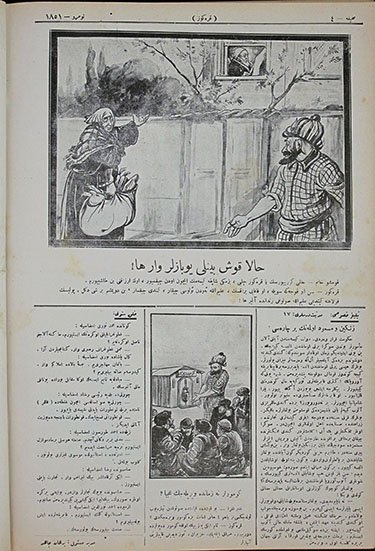38. Today in 1920s Turkey: 12 December 1925 (Bird-Brained Bigot or Principled Protester?)

(Cartoon, Karagöz, 12 December 1925, no. 1851, page 4.)
Comments:
On 25 November 1925 a new law was passed banning the wearing of the fez by citizens of the new Turkish state and restricting the use of turbans and other religious attire to members of the ulema (religious officials). In the months leading up to this reform newspapers and satirical journals weighed in on the issue. As several previous posts demonstrate, they often offered support to the administration’s cause by encouraging citizens to adopt the Western-style hat and dispose of their obsolete fezzes.
In the days and weeks following the so-called “hat reform” (şapka devrimi) citizens across the country opposed to the new public dress-code regulations staged various forms of protest and resistance. As a result of the more organized, public protests (especially those that took place in Kayseri, Maraş, Sivas, Rize, and Erzurum) hundreds were arrested and several dozen executed. Fearing legal repercussions or bodily harm, many resolved to silently protest the reform by avoid the public sphere rather than surrendering to the demands of the new administration. This is the method of protest criticized in today’s cartoon. Here, Karagöz (the journal’s mascot located in the lower right corner of the cartoon) scolds the old man for not accepting the new “dress code” and for making his wife run all of the household errands while he sits comfy at home, reading his newspaper. Clearly galvanized by the government’s violent crackdown during previous encounters with protestors, Karagöz’s intolerant and threatening tone suggests that this man’s unwillingness to comply with the newly legislated norm is no laughing matter.
Police did indeed have the authority to fine those still wearing fezzes in public. While various western-style brimmed hats were the prescribed substitute for the fez, police were less likely to enforce the wearing of the hat (so long as they are not wearing fezzes). Thus, many turned to various caps such as the kasket. For instance post # 2: Trafik Canavarı or The Beast of Bad Driving from 1927 presents the range of headgear-related adaptations that had sprung up since the passing of the law. Fictitious as the cartoon may be, in multiple frames we see common citizens wearing a mixture of European-style hats, the kasket, and some even proudly displaying their bare heads.
English:
Bird-Brained Bigots Still Exist!
Neighbor woman: You see my situation, Mr. Karagöz. In order to not wear a hat, ours here isn’t leaving the house so I am carrying all of the household provisions.
Karagöz: You tell that husband of yours he should abandon that mentality or else he won’t leave the house—a corpse will. That I heard it is nothing, but if word gets to the ears of the police your next breath will be in a prison!
Türkçe:
Hala Kuş Beyinli Yobazlar Var Ha!
Komşu Hanım: Halimi görüyorsun ya Karagöz çelebi, bizimki şapka giymemek için evden çıkmıyor, evin erzakını ben taşıyorum.
Karagöz: Sen o kocana söyle, o kafayı bıraksın, alimallah evden ölüsü çıkar, kendi çıkmaz, ben duymuşum birşey değil. Polisin kulağına gitti mi alimallah soluğu zindanda alırsın ha!
Other Sources Consulted:
Yılmaz, Hale. “Dressing the Nation’s Citizens: Men’s Clothing Reforms in the Early Republic.” In: Becoming Turkish: Nationalist Reforms and Cultural Negotiations in Early Republican Turkey, 1923-1945, 22-77. New York: Syracuse University Press, 2013.

(Entire page, Karagöz, 12 December 1925, no. 1851, page 4.)